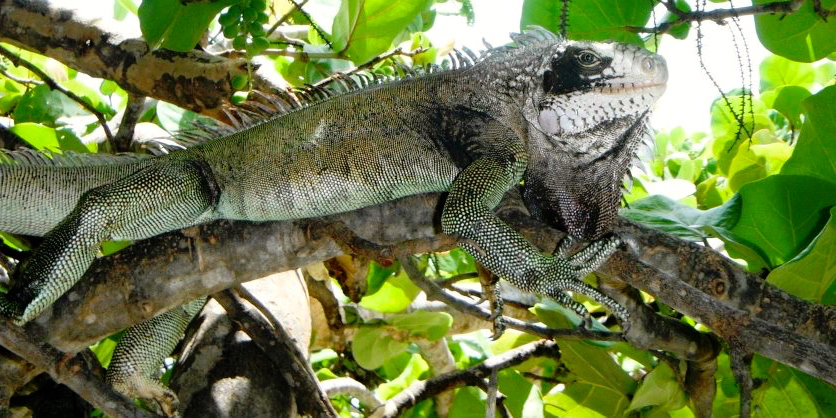
Using genetic testing, researchers have discovered a major clue to the origin of the green iguana that is so prevalent in the Virgin Islands.
While there is strong reason to believe that iguanas in Puerto Rico and some other areas are invasive species introduced through the international pet trade, most of those on St. Thomas and St. Croix – as well as those on nearby Vieques – likely are descendants of iguanas that lived on other Caribbean islands and were introduced naturally in the pre-Columbian era.
It’s unclear what this may mean for the future of the prolific reptile, which has been the subject of much controversy in the territory in the past few decades.
The iguana is not, and never has been, on the Virgin Islands Endangered Species list. But it was protected under a separate law passed in the early 1970s and titled the Iguana and Agouti Act, which made it illegal to kill, injure or sell those animals. The agouti was introduced to the territory in mid-20th century and soon died out.
But the iguana population thrived and grew so much that by the turn of the century, it was widely viewed as a pest by farmers, hoteliers, restaurant owners, and home gardeners.
In 2013, the Legislature quietly repealed the Iguana and Agouti Act.
Now, the researchers who conducted the recent study suggest that the repeal be amended until further study can be made about the origin of the green iguana in the Virgin Islands.
The preliminary findings concerning the territory are only a small part of the study.
The research that resulted in the “Origin of the Green Iguana (Iguana iguana) Invasion in the Greater Caribbean Region and Fiji” as published in April by Springer Nature Switzerland, was funded by the National Science Foundation through the Louis Stokes Alliance for Minority Participation, Puerto Rico Chapter.
The authors were Christina N. De Jesus, Wilfredo Falcon, Ximena Velez-Zuazo, Riccardo Papa, and Catherine Lyn Malone.
The scientists sampled more than 100 iguanas from populations found in Puerto Rico, Fiji, the Cayman Islands, Florida, the Dominican Republic, St. Thomas, St. Croix, and a U.S. pet store. They focused largely on the pet trade as a possible driver of the spread of iguanas as invasive species.
That trade was booming in recent decades. The paper says nearly 3.7 million green iguanas were exported from Central and South America from 1983 to 1994. In a five-year period from 2004 to 2009, El Salvador, alone, exported 1.9 million of the reptiles.
Many of the exports went to the U.S. mainland, where some were sold and many were distributed to other countries. In 1983-1994, the U.S. received 2.9 million green iguana pets; from 2001-2008, it received another 971,602, according to the report.
When the researchers did genetic testing on sample iguanas from the areas covered in the study, they found that most of the animals had genetic links to reptiles found in Colombia and El Salvador “two countries with multiple, industrial-sized pet iguana populations.”
However, it was a different story for Vieques and the Virgin Islands. While there was some evidence to suggest the pet trade may have had some effect, particularly on St. Croix, the primary link for iguanas on those islands is to green iguanas found in Saba and Montserrat, a type that is not commonly found in the pet trade.
For the Virgin Islands, “the possibility of introduction by indigenous people or by natural dispersal cannot be disregarded,” the report states. “Efforts should be made to prevent further import of green iguanas to St. Thomas and St. Croix to retain possible remnant populations introduced by indigenous peoples or of natural arrival while their origin is resolved.”
The sampling taken from St. Thomas was only from one location, so more study is needed. “In the meantime, we propose a revision to the amendment of the Bill 30-0277 (which repealed protections for iguanas) while origin status is researched.”
There was little publicity when the Legislature repealed the Iguana and Agouti Act eight years ago, although the controversy over whether or not to protect iguanas had been ongoing.

“I don’t remember any hullaballoo about it,” former Sen. Craig Barshinger said when contacted by the Source this week. Barshinger, a co-sponsor of the action, said he couldn’t recall all the background off-hand, but suggested the bill may even have been offered as an amendment to an unrelated measure. “We did not have a lot of hearings on it.”
However, he described it as a good-faith action, taken in response to requests from residents and businesses and after consultation with staff at Fish and Wildlife.
In the 1970s, iguanas were a novelty. But by the early 2000s, “They were de facto no longer endangered,” he said. For some people they had become serious pests.
While he expressed misgivings about reinstating protections, Barshinger also said, “The great thing about law is, when things change, you can change law … Every piece of legislation is constantly under review” by the people.
The Fish and Wildlife Division of the Department of Planning and Natural Resources has published what its director, Nicole Angeli, calls “non-lethal control methods” for iguanas, which it recognizes can be nuisance pests.
The advice includes blocking off burrows so iguanas cannot build nests in them, erecting fencing or netting to protect plants from hungry reptiles, and the use of poles or nets to capture individuals.
While a DPNR flyer – Iguana Nuisance flyer – discusses only relocating iguanas, which should be done only with permission from the landowner of the recipient property, Angeli said the law does allow for them to be euthanized.
“There are no ‘official’ invasive species of reptiles at this time,” Angeli said in response to questions, “as the long history of the Virgin Islands flora and fauna is still being revealed through new and exciting scientific methods like genetics and habitat modeling.”


